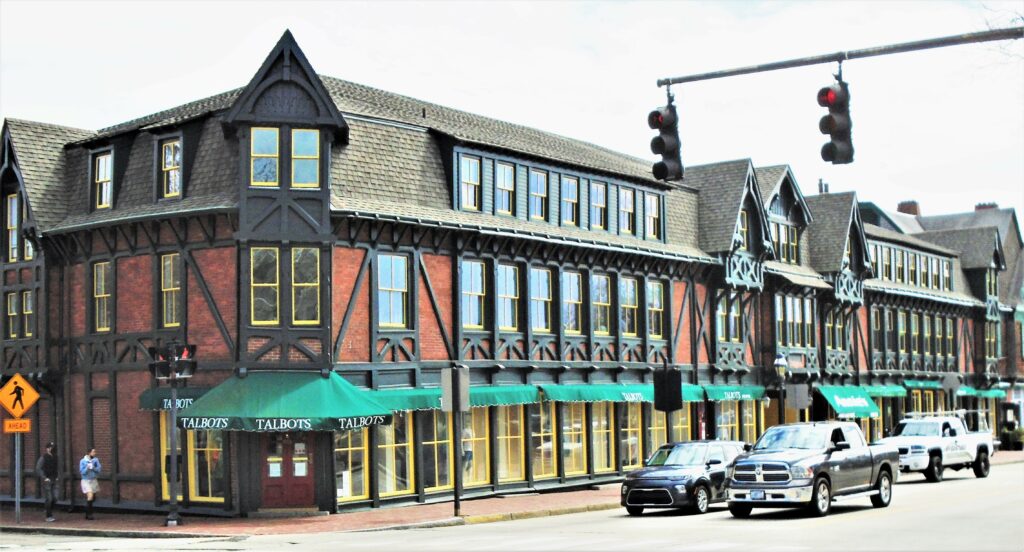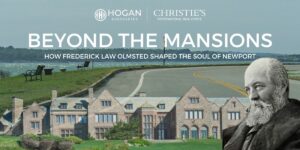

Richard Morris Hunt was a visionary architect who helped shape the landscape of Newport, RI. He was the first American to be accepted into the prestigious École des Beaux-Arts in Paris, where he honed his skills under the tutelage of renowned architect Hector Lefuel. After nearly a decade in Europe, Hunt returned to the United States in 1855, ready to make his mark on the world. He brought the grandeur of European architecture to American shores, particularly to the playgrounds of the newly minted millionaires in Newport, RI. Hunt left his mark on Newport by designing several prominent buildings during the Gilded Age. Here are some of his most notable creations:
The John N. A. Griswold House


Built in 1864, it’s considered one of the earliest examples of the Stick style in America. This architectural style emphasizes exposed wooden beams and a rectangular form. The house was originally a residence for John Noble Alsop Griswold, a prominent merchant involved in the China Trade. Today, the former home serves as one of the galleries of the Newport Art Museum. This allows visitors to experience the unique architecture while enjoying art exhibitions.
The Breakers

Arguably Hunt’s most iconic creation in Newport is The Breakers, a 70-room Gilded Age masterpiece built for Cornelius Vanderbilt. Stepping inside is like entering a Beaux Arts palace. Built from 1893-1895, it contains grand staircases, opulent ballrooms, and intricate marquetry flooring that all speaks to the Vanderbilt’s desire to showcase their social standing. It remains a testament to Hunt’s mastery of scale and his ability to translate European grandeur to the American style. Scenes from HBO’s Emmy-nominated show, “The Gilded Age” were filmed at The Breakers, among other Gilded Age locations.
Marble House

Hunt’s legacy in Newport extends far beyond The Breakers. Marble House, built from 1888-1892, is another Vanderbilt mansion designed by Hunt. It boasts a dazzling white exterior modeled after the Palace of Versailles. William Vanderbilt commissioned Hunt to design the finest summer house in Newport as a birthday present for his wife, Alva. The mansion was also used as a filming location for the show, “The Gilded Age”.
The Traveler’s Block


This mixed-use commercial building, constructed in 1870-1871, stands as another testament to Hunt’s presence in shaping Newport’s architectural landscape. The Travers Block showcases his versatility and early influence on American architecture. It is situated on the east side of Bellevue Avenue at the intersection of Bellevue Avenue and Memorial Boulevard and makes up the first block of storefront and office spaces running from 166 to 184 Bellevue Avenue.
Hunt’s influence wasn’t limited to the mansions of the ultra-wealthy. He also designed cottages, churches, and even public buildings in Newport. Though smaller in scale, these structures still showcased his signature attention to detail and commitment to quality craftsmanship. He played a pivotal role in shaping the American architectural landscape. By establishing a new standard for luxury residences, he inadvertently fueled the competitive spirit among the Gilded Age elite, leading to a period of architectural innovation.
Today, as you walk the streets of Newport, RI, and marvel at the architectural gems that line them, remember Richard Morris Hunt. He wasn’t just an architect; he was an artist, a businessman, and an educator. His legacy is a testament to the transformative power of architecture and its ability to capture the spirit of an era. The grand mansions of Newport stand not just as symbols of wealth, but as enduring testaments to his vision and artistry.
If you’re interested in buying or selling a property in Newport, RI or its surrounding communities, Hogan Associates Christie’s International Real Estate will gladly be your guide. Call us at (401) 680-6588 or send a message to info@hoganri.com.







